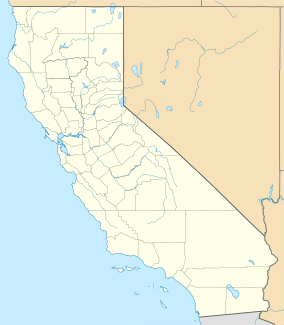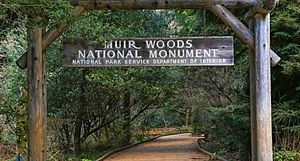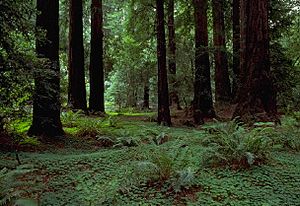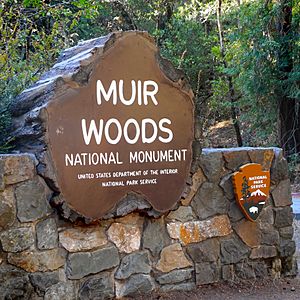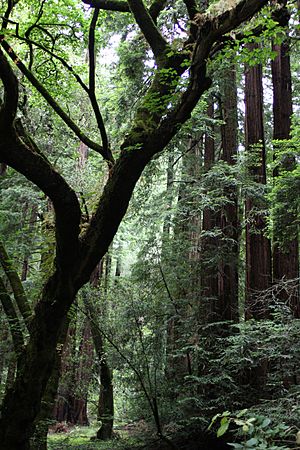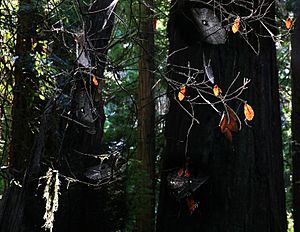Muir Woods National Monument facts for kids
Quick facts for kids Muir Woods National Monument |
|
|---|---|
|
IUCN Category III (Natural Monument)
|
|
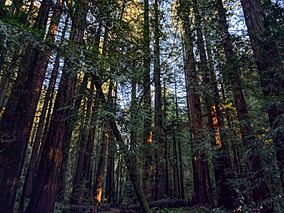
Redwood trees at the Muir Woods National Monument
|
|
| Location | Marin County, California, U.S. |
| Nearest city | Mill Valley, CA |
| Area | 554 acres (224 ha) |
| Created | January 9, 1908 |
| Visitors | 957,932 (in 2018) |
| Governing body | National Park Service |
| Website | Muir Woods National Monument |
| Designated: | January 9, 2008 |
| Reference #: | 07001396 |
Muir Woods National Monument is a special protected area in the United States. It is looked after by the National Park Service, which manages many of America's amazing natural places. This monument is named after John Muir, a famous naturalist who worked hard to protect nature.
Muir Woods is located in Marin County, California, close to the Pacific Ocean. It's about 12 miles (19 km) north of San Francisco. The monument covers 554 acres (2.2 square kilometers), and a big part of this land, 240 acres (0.97 square kilometers), is filled with very old Redwood trees. These are some of the last remaining old-growth redwood forests in the San Francisco Bay Area.
Contents
Exploring Muir Woods: Nature's Beauty
The Redwood Forest Ecosystem
Muir Woods is home to an ancient coastal redwood forest. Because it's so close to the Pacific Ocean, the forest often gets covered in a cool, misty fog. This fog creates a very wet environment, which helps plants grow strong and tall. The fog is super important for the redwoods, as they use its moisture during dry seasons, especially in the summer.
| Weather chart for Muir Woods National Monument | |||||||||||||||||||||||||||||||||||||||||||||||
|---|---|---|---|---|---|---|---|---|---|---|---|---|---|---|---|---|---|---|---|---|---|---|---|---|---|---|---|---|---|---|---|---|---|---|---|---|---|---|---|---|---|---|---|---|---|---|---|
| J | F | M | A | M | J | J | A | S | O | N | D | ||||||||||||||||||||||||||||||||||||
|
64
12
7
|
74
16
10
|
86
20
9
|
45
20
9
|
1
17
10
|
4
20
12
|
1
23
14
|
2
22
14
|
10
27
13
|
25
23
12
|
111
14
8
|
177
9
6
|
||||||||||||||||||||||||||||||||||||
| temperatures in °C precipitation totals in mm |
|||||||||||||||||||||||||||||||||||||||||||||||
|
Imperial conversion
|
|||||||||||||||||||||||||||||||||||||||||||||||
Weather and Climate in Muir Woods
The monument stays cool and moist all year. Daytime temperatures usually range from 40 to 70 degrees Fahrenheit (4 to 21 °C). Winters have a lot of rain, but summers are mostly dry. However, the fog helps by dripping moisture onto the trees, which is called "fog drip." The park gets about 39 to 47 inches (1,000 to 1,200 mm) of rain each year.
Soils Supporting Giant Redwoods
The redwoods grow in rich, brown soil that has a lot of decomposed plant material. This soil can sometimes be gravelly or sandy. It drains water well and is slightly acidic. This special soil helps the massive redwood trees thrive.
History of Muir Woods: Protecting a Natural Treasure
Redwoods Through Time
Millions of years ago, ancestors of redwood trees grew all over the United States. Today, the coast redwood (Sequoia sempervirens) only grows in a narrow, cool strip along the coast from Monterey County in the south to Oregon in the north.
Before people started cutting down trees for wood, there were about 2 million acres (8,000 square kilometers) of old-growth redwood forests along the California coast. By the early 1900s, most of these forests had been cut down.
How Muir Woods Was Saved
Just north of the San Francisco Bay, one valley called Redwood Canyon remained untouched. This was because it was hard to reach. William Kent, a politician from California, noticed this special place. He and his wife, Elizabeth Thacher Kent, bought 611 acres (2.5 square kilometers) of land for $45,000 to protect the redwoods.
In 1907, a water company wanted to build a dam on Redwood Creek, which would have flooded the valley. Kent did not want this to happen. To stop the company, he gave 295 acres (1.2 square kilometers) of the redwood forest to the United States government. This was a clever way to protect the land from being flooded.
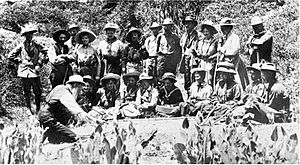
On January 9, 1908, President Theodore Roosevelt declared the land a national monument. It was the first national monument created from land donated by a private person. William Kent wanted the monument to be named after his friend, the naturalist John Muir. Muir's efforts helped create the National Park system. President Roosevelt agreed, saying, "My Dear Mr. Kent: By George you are right!"
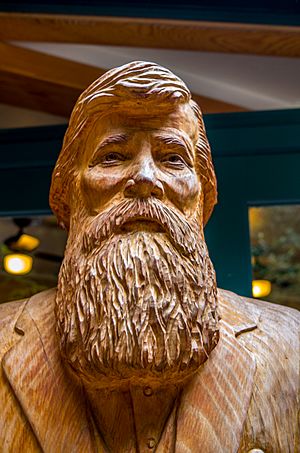
In 1928, a memorial was put up for William Kent at his favorite tree, a Douglas fir. This tree was very tall, about 280 feet (85 meters). Over the years, storms caused the tree to lean more and more. In 2003, it finally fell, but the trails were later fixed and reopened.
Muir Woods and Important Events
After the Golden Gate Bridge was finished in 1937, more people visited Muir Woods. The number of visitors tripled to over 180,000. Today, it's one of the most popular places to visit in the San Francisco Bay Area.
In 1945, after President Franklin D. Roosevelt passed away, delegates from 50 countries met in San Francisco to create the United Nations Charter. On May 19, they held a special ceremony in Muir Woods' Cathedral Grove to honor him. A plaque was placed there in his memory.
The monument was officially added to the National Register of Historic Places on January 9, 2008.
Wildlife and Plants of Muir Woods
Amazing Redwood Trees and Other Plants
The main attraction at Muir Woods is the coast redwood (Sequoia sempervirens). These trees are famous for being incredibly tall. While some redwoods can grow to almost 380 feet (115 meters), the tallest tree in Muir Woods is 258 feet (79 meters). It's amazing to think these giant trees grow from a seed no bigger than a tomato seed! Most redwoods in the monument are between 500 and 800 years old, and the oldest is at least 1,200 years old.
Other types of trees also grow under the redwoods. Three common ones are the California bay laurel, the bigleaf maple, and the tanoak. Each of these trees has found a special way to grow in the low light under the tall redwoods. For example, the bigleaf maple has very large leaves to catch more of the dim sunlight.
Fish Life in Redwood Creek
Redwood Creek, which flows through the monument, is a very important home for coho salmon and steelhead trout. These fish are considered threatened or endangered, meaning their populations are very low. The coho salmon here are special because they have never been moved from other places, so their DNA is unique.
These salmon swim from the ocean back to the creek to lay their eggs, usually in December and January after heavy rains. For a few years, very few salmon were seen, which worried scientists. But thanks to efforts by the National Park Service to restore Muir Beach and the creek, salmon have started to return. In 2010, about 45 coho salmon came back to spawn, which was great news!
Birds of the Redwood Forest
Muir Woods is home to over 50 different kinds of birds. This number is a bit low compared to other forests because there aren't many insects here. The chemicals in the redwood trees keep insects away, and the shade limits the number of flowers and fruits for birds to eat.
Sometimes, you might spot a northern spotted owl or a pileated woodpecker. Even though spotted owl numbers are decreasing in other places, they seem to be doing well in Muir Woods. The National Park Service is watching them closely and has found that the owls are finding mates and raising their young successfully.
Mammals Living in Muir Woods
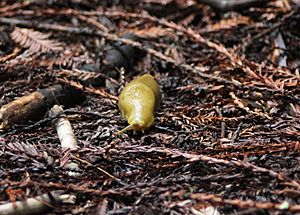
Many different mammals live in the monument. They range in size from tiny 4-inch (10 cm) American shrew moles to much larger mule deer. Most mammals here are active at night or live underground. You might commonly see Sonoma chipmunks and western gray squirrels.
Bears used to live in the area, but most were gone due to changes in their habitat. However, in 2003, a black bear was seen wandering in Marin County, including Muir Woods. The monument is also home to 11 types of bats, which sometimes use hollows in old redwoods as places to raise their young.
Visiting Muir Woods: What to Expect
Muir Woods is a park for people who want to walk and explore. Cars are only allowed at the entrance. There are different hiking trails for all skill levels. You cannot have picnics, camp, or bring pets into the monument.
Muir Woods is a very popular place, with up to 6,000 visitors a day during busy times. Because so many people come, parking can be very difficult. To help with this, the park started a reservation system in 2018. You now need to reserve a spot for your car or a seat on the shuttle bus before you visit.
Parking and Shuttle Services
Since 2018, you must make a reservation for all vehicles and shuttle riders. Marin Transit runs a shuttle service on weekends and holidays, and on some busy weekdays. The shuttle picks up visitors from Sausalito, Marin City, or Mill Valley. The park recommends using the shuttle to avoid parking problems.
A parking reservation costs $8.50 per vehicle, and a shuttle spot is $3.25 per person. There is also an entrance fee of $15.00 per person to get into Muir Woods. The park and shuttle are open every day of the year, from 8:00 am until sunset.
Where to Stay and Other Facilities
There are no places to camp or stay overnight inside Muir Woods. It's a day-use park only. However, there are camping areas in the nearby Mount Tamalpais State Park.
Inside the monument, you'll find restrooms near the entrance and cafe. The Muir Woods Trading Company cafe and gift shop offers food and souvenirs. The main trail is a 2-mile (3.2 km) loop, and a shorter 0.5-mile (0.8 km) loop is accessible for wheelchairs. The Visitor Center has exhibits about redwood ecology and conservation.
Activities at Muir Woods
Hiking and Biking Trails
The main trail is paved and has boardwalks. It starts at the entrance and goes into the old-growth redwood forest along Redwood Creek. Other unpaved trails connect to trails in Mount Tamalpais State Park. Bicycles are only allowed on special fire roads, not on the main hiking trails.
Special Events and Ranger Programs
The annual Dipsea Race, a running race from Mill Valley to Stinson Beach, passes through Muir Woods every June.
Park rangers and volunteers often give short talks and guided tours. These programs teach visitors about redwood trees, how climate change affects the forest, and the history of Muir Woods. Longer hikes and special programs are also offered sometimes, but you usually need a reservation for those.
If you want to have a wedding, film a movie, or hold a special event in the monument, you need to get a permit first.
Impact of Tourism on Muir Woods
Positive Effects of Visitors
In 2018, many visitors came to Muir Woods and other nearby parks like the Golden Gate National Recreation Area. These visitors spent a lot of money in the towns around the parks, which helped local businesses and created many jobs. This shows how protecting natural areas can also help the economy.
A study by government economists found that visitors to national parks across the U.S. spent over $20 billion in nearby communities. This spending supported hundreds of thousands of jobs and added billions of dollars to the U.S. economy.
Challenges from Popularity
However, Muir Woods' popularity has also caused some problems, especially traffic jams on the roads leading to the monument. People living nearby have complained about the increased traffic. To fix this, the National Park Service created the parking reservation system and put limits on roadside parking.
Even with these changes, traffic and parking can still be a challenge for both tourists and local residents, especially during busy times.
Protecting Surrounding Ecosystems
To truly protect Muir Woods, it's important to also take care of the natural areas around it. The park works with other groups to restore and protect places like Redwood Creek and Big Lagoon at Muir Beach. These efforts help improve the health of the ecosystem and create better homes for wildlife like coho salmon and the northern spotted owl.
The National Park Service and the Golden Gate National Parks Conservancy have worked together to restore the last half-mile of Redwood Creek before it flows into the Pacific Ocean. For over 100 years, farming, logging, and road-building had damaged the creek. This threatened local fish like coho salmon and steelhead trout. Also, the poor condition of the creek caused flooding during storms. By restoring Redwood Creek, the government's protection of Muir Woods also helps the surrounding area and its wildlife.
Muir Woods in Arts and Stories
Japanese composer Tōru Takemitsu wrote a classical guitar piece in 1995 called "In the Woods." The third part of this music is named "Muir Woods," inspired by this very forest.
Muir Woods has also appeared in movies and books. Characters in Alfred Hitchcock's 1958 film Vertigo visit Muir Woods, though the scene was filmed elsewhere. The monument was also a setting in the Planet of the Apes movies (Rise of the Planet of the Apes, Dawn of the Planet of the Apes, and War for the Planet of the Apes), though these were filmed in Canada. Author Jack Kerouac wrote about hiking through Muir Woods in his 1958 novel The Dharma Bums. In the animated series Big Hero 6: The Series, a fictional version of the forest is called "Muirahara Woods."
Images for kids


